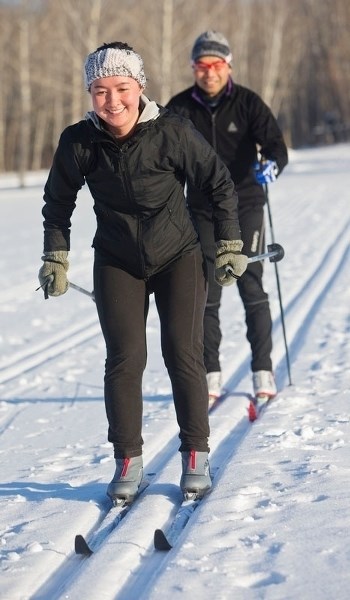Gazette reporter Amy Crofts is trying a different workout each month in an attempt to inspire people to spice up their fitness routine. If you have a workout idea, email: [email protected]
It was a beautiful Sunday morning at the Kingswood Day Area – the sun was shining, the snow was glittering and I wasn't falling on my butt … or my face.
Aside from an impromptu lesson in Lake Louise a few years back by my brother, who told me to strap on a pair of skis and just move one foot in front of the other (what resulted was rigid Frankenstein-esque movements and sore legs – not from skiing, but from falling), this was my first guided experience into cross-country skiing.
Under the careful watch of Ken Chin, interim president of the St. Albert Nordic Ski Club (STANSKI), I suited up and was schooled in the basics of classic Nordic skiing.
The equipment
Ski length is proportional to a skiers' height and weight, says Chin. There must be just the right combination of length and flex so your skis will grip the snow and glide.
Skis are made from a laminate wood core with surrounding composite layers above and below, typically consisting of fiberglass.
Compared to classic skis, skating skis (think the type of skiing that is used in biathlon) are shorter, lighter (honeycomb core) and stiffer, in order to provide more manoeuvrability. Skating skis have straighter edges and keep in constant contact with the snow while classic cross-country skis have an inward curve.
Expect to spend between $400 and $650 on a good pair of cross-country skis, says Chin.
To get your classic skis prepped for use, skis require glide wax and grip wax – the wax controls the level of traction on the snow.
The "grip zone" or "wax pocket" is in the centre of the ski base under the binding. The "glide zones" are between the binding and the tip and the heel and tail of the ski.
If snow conditions require more grip, expand your wax pockets, explains Chin. Apply a light, thin, coat of wax (don't "cookie dough it!") and use a cork block to distribute and melt the wax into the base.
Ski boots should fit well with enough room to wiggle your toes. You won't need to wear thick socks in most because of insulation in the boot itself.
Chin recommends combination boots because you can use them for both a classic ski as well as a skate ski.
Ski poles are used for extra propulsion. For the classic technique, a ski pole should fit just below your armpit.
The workout
There are three types of skiers: the walker, the strider and the glider, says Chin.
The walker is rigid, essentially shuffling their feet with skis on. A strider is able to transfer weight right down the middle of the skis. Their movement is much more dynamic – they are pre-loading power on one leg and gliding with the other.
When a glider skis, it is as if they are skiing on one ski. They are leaning forward, knees bent, movements are much like walking, heels raise with each step, fluid and nimble.
Chin and I head to the tracks just outside the Kingswood shelter in the day-use area. I start off with no poles, ski on one foot and practice gliding on one ski, propelling myself with the other foot.
Several more drills involving pushing and gliding lead up to the "diagonal stride" technique – a kicking action performed by one leg, followed by a weight shift to the gliding ski and then a pole push-off.
When used correctly, the poles act like "a turbo charger to double up your horsepower," says Chin, demonstrating the "double poling" technique, driving the poles down and back, while crunching his mid-section.
With seamless transitions between the diagonal stride, double poling and the "kick double pole" (a single mule-like kick, followed by a double pole push) in between, Chin effortlessly cruises back and forth on the snow.
My skiing technique can only be described as a walker, much like the "walkers" (zombies) on The Walking Dead.
"Cross country skiing is similar to swimming. You use your whole entire body – legs, arms and the initiation of poling is from your core," says Chin.
For certain events or terrains where the double poling technique is used the majority of the time, "it's like doing sit-ups for 30 minutes," says Chin.
Illustrating just how good of an aerobic workout cross-country skiing is, a Swedish study published in the Journal of Applied Physiology in 2013 found that lifelong cross-country skiers who trained four to six times a week, had approximately twice the cardiovascular and muscular fitness compared to the control group. Participants of the control group did not do any formal exercise.
Although my hip flexors are a tad sore after my ski lesson, I won't let that detract me from taking up a new winter sport and taking advantage of St. Albert's more than 15 km of ski trails. I've signed up for STANSKI's adult novice lessons for January.
Need Lessons?
STANSKI offers both children and adult lessons as well as a skate ski course, with next sessions starting in January. Rental equipment is available for the duration of the lessons.
Check out their website for details: http://www.stalbertnordic.com
Cross-country ski rentals are available at Mountain Equipment Co-op in Edmonton and the Edmonton Nordic Ski Club. STANSKI no longer provides ski rentals, outside of lessons.




